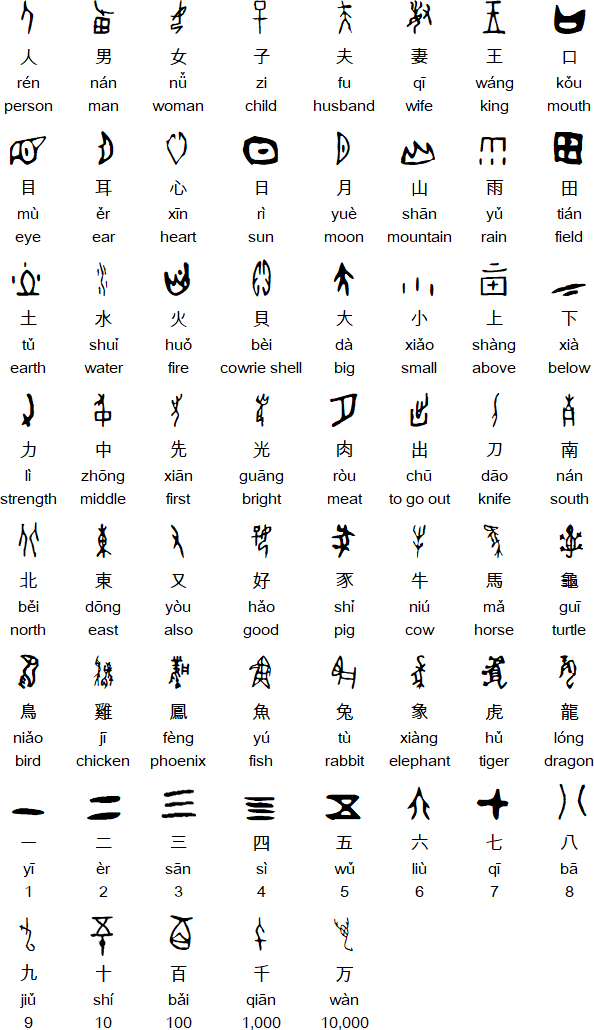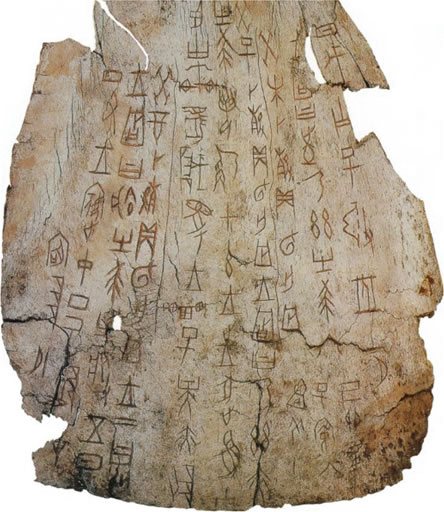The oldest inscriptions that are recognised unequivocally as Chinese date from about 1200 BC and were found in Anyang, the capital of the Shang Dynasty (商朝 - 1600-1046 BC) in 1895. They consist of short texts inscribed on ox scapulae and turtle plastrons and are known as oracle bones (甲骨 - jiǎgǔ), and the script is known as the oracle script (甲骨文 - jiǎgǔwén) or "shell bone script".
The oracle bones were used for divination, a process which involved inscribing a question with a bronze pin, then heating the bones and inspecting the resulting cracks to divine answers to one's questions. Most of the questions involved hunting, warfare, the weather and the selection of auspicious days for ceremonies.
The Oracle Bone Script was used between about about 1300 and 1100 BC according to some sources, and between 1500 and 1000 BC according to others.
Some 400,000 fragments with inscriptions in the Oracle Bone Script have been found. Several thousand bones and plastrons have been reconstructed and many thousands of texts have been studied. The texts contain over 30,000 distinct characters, which are thought to be variant forms of around 4,000 individual characters, and scholars believe that they can understand between 1,500 and 2,000 of these characters. There may be 5,000 or so individual characters used on the Oracle Bones, not including variant forms, and possibly twice as many were used in everyday life.
Structural the Oracle Bone characters resemble modern Chinese characters in that some of them are combinations of two or more characters, and there is a high degree of abstraction in the characters. This suggests that the script was invented long before the Shang Dynasty.
Some examples of Oracle Bone characters with their modern equivalents and Mandarin pronunciation.


Source: http://www.art-virtue.com/introduction/2-general.htm
Information about the oracle bones and the oracle bone script
http://www.chinapage.com/oracle/oracle00.html
http://www.lib.cuhk.edu.hk/uclib/bones/bones.htm
http://en.wikipedia.org/wiki/Oracle_bones
http://www.chineseetymology.org/why_study.aspx#oracle
http://www.ancientscripts.com/chinese.html
Examples of Oracle Bone inscriptions
http://www.chinapage.com/oracle/oraclebone1.html
Written Chinese: Oracle Bone Script, Simplified characters, Bopomofo, Types of characters, Structure of written Chinese, Evolution of characters, How the Chinese script works, Xiao'erjing, General Chinese
Spoken Chinese: Mandarin, Dungan, Wu, Shanghainese, Wenzhounese, Yue, Cantonese, Weitou, Min, Jian'ou, Taiwanese, Teochew, Fuzhounese, Puxian, Hakka, Xiang, Gan, How many people speak Chinese?
Other Chinese pages: Chinese numbers (數碼) | Chinese classifiers (量詞) | Electronic dictionaries | Chinese links | Books: Chinese characters and calligraphy | Cantonese | Mandarin, Shanghainese, Hokkien and Taiwanese
Akkadian Cuneiform, Ancient Egyptian (Demotic), Ancient Egyptian (Hieratic), Ancient Egyptian (Hieroglyphs), Chinese, Chữ-nôm, Cuneiform, Japanese, Jurchen, Khitan, Linear B, Luwian, Mayan, Naxi, Sawndip (Old Zhuang), Sui, Sumerian Cuneiform, Tangut (Hsihsia)
Page last modified: 15.03.23
[top]
You can support this site by Buying Me A Coffee, and if you like what you see on this page, you can use the buttons below to share it with people you know.

If you like this site and find it useful, you can support it by making a donation via PayPal or Patreon, or by contributing in other ways. Omniglot is how I make my living.
Note: all links on this site to Amazon.com, Amazon.co.uk
and Amazon.fr
are affiliate links. This means I earn a commission if you click on any of them and buy something. So by clicking on these links you can help to support this site.
[top]